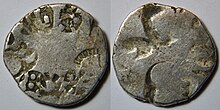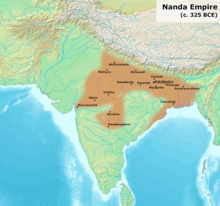Mahapadma Nanda
This article needs additional citations for verification. (October 2022) |
| Mahapadma Nanda | |
|---|---|
| Samraat | |
 A silver coin of 1 karshapana of King Mahapadma Nanda or his sons 4th century BCE | |
| First Emperor of Nanda Empire | |
| Reign | c. mid 4th century BCE |
| Predecessor | Mahanandin |
| Successor | Dhana Nanda |
| Issue | Dhana Nanda |
| Dynasty | Nanda |
| Father | Mahanandin |
| Religion | Hinduism |
Mahapadma Nanda (IAST: Mahāpadmānanda; c. mid 4th century BCE), according to the Puranas, was the first Emperor of the Nanda Empire of ancient India. The Puranas describe him as a son of the last Shaishunaga king Mahanandin and a Shudra woman, and credit him with extensive conquests. The different Puranas variously give the length of his reign as 28 or 88 years, and state that his eight sons ruled in succession after him.
Etymology
According to the Puranas, the first Nanda king was called Mahapadma or Mahapadma-pati (literally, "lord of the great lotus").[1]
Nanda was also known as Mahapadma or Mahapadma Nanda for the amount of gold he collected by winning wars and taxes. Mahapadma is a number = Padma x 1000 x100 = 10^37. He buried those many gold coins in pots along the banks of river Ganga.[2]
In Buddhist texts name of Mahapadma Nanda is found as Ugrasena.
Title
The Puranas describe him as ekarat (sole sovereign) and sarva-kshatrantaka (destroyer of all the Kshatriyas).[2][3] because he was the first emperor of ancient India and defeated Kshastriyas (warriors and rulers) of Mahajanapada period include Maithalas, Kasheyas, Ikshvakus, Panchalas, Shurasenas, Kurus, Haihayas, Vitihotras, Kalingas, and Ashmakas.[4]
Dating
The Matsya Purana assigns Mahapadma an incredibly long reign of 88 years, while the Vayu Purana mentions the length of his reign as only 28 years.[5] The Puranas further state that Mahapadma's eight sons ruled in succession after him for a total of 12 years, but name only one of these sons: Sukalpa.[6]
- Indologist F. E. Pargiter dated Nanda's coronation to 382 BCE.
- Historian R. K. Mookerji dated Nanda's 364 BCE.[7]
- Historian H. C. Raychaudhuri places Nanda's coronation to c. 345 BCE.[8]
The beginning of Nanda reign is also assigned as early as 5th century BCE.[9]
Early Life
Mahapadma Nanda's mother was a Shudra. He belonged to the Hindu caste of Barber. He was given the moniker "Destroyer of Kshatriyas" since he belonged to the lower caste Shudra and destroyed all the Kshatriyas.
Mahapadma Nanda sought to assume the throne after his father Mahanandin died. However, he had to contend with the sons of Mahanandin's other wives. As a result, he took the throne by murdering Mahanandin's other sons. His dynasty was known as the Nanda dynasty. He established Pataliputra (Patna, Bihar) as his kingdom's capital.
Reign
The Mahapadma Nanda will be regarded as a magnificent monarch of ancient India, whose subjects enjoyed the benefits of life without fear of outside intruders during his reign.
Conquests

Mahapadma Nanda, the first great North Indian King, who established strong kingdom Magadha. He vanquished the old dynasties and uprooted the entire Kshatriya dynasties which were contemporary to him. He expanded the Magadha kingdom from Punjab in the west to Bengal in the east and Vindhya mountains in the south. Almost the present North India and ruled by him.
He became very more powerful king and himself declared Ekachhatra, which means the only emperor in the entire land. His dream of sole ruler came into truth. He gave a new life to the idea of Magadha imperialism, which was running low key after the death of Ajathasatru.
He defeated the northern dynasties and incorporated them into his reign. Maithalas, Kasheyas, Ikshvakus, Panchalas, Shurasenas, Kurus, Haihayas, Vitihotras, Kalingas, and Ashmakas were all defeated by him.
Administration
He had a strong administrative system in place and appointed tax collectors. Their coffers were constantly replenished by taxes and carefully organized economic activity. The wealth of the Nanda kingdom expanded dramatically during his reign. Agricultural infrastructure was developed in a big way. This enhanced the kingdom's economy significantly.
Moreover, he collects a substantial amount of land tax from his extensive kingdom and utilized the money for the maintenance of his army. He was very prosperous and concentrated on Agriculture and water facilities before the drought occurs. So that he dug the canals from the Ganges river and made fertile the lands.
After conquered the Kalinga kingdom, he recognized Kalinga was drought affected area, so immediately established a canal system in the region and ruined the drought affected areas, and made them greenery.
Military strength
At the most conservative estimations, Mahapadma Nanda's army numbered 200,000 soldiers, 20,000 cavalry, 3,000 war elephants, and 2,000 war chariots.No intruder dared to attack Mahapadma Nanda because of this massive military fortification.
The army's strength increased as the coffers were restored. His dominion was the most prosperous of any at the time. He carried an image of "Jina" as a victory trophy and annexed Kalinga to Magadha. Because of his enormous army, he is also known as Ugrasena in Pali scriptures. The Nandas were incredibly wealthy and powerful.
Religion
During his reign, individuals were free to practise their religion without fear of persecution. Hinduism, Jainism and Buddhism were followed by the population. The kings of the Nanda kingdom, on the other hand, were Hindus.
Legacy
- The first Emperor of the ancient Indian Nanda Empire was Mahapadma Nanda.
- He belonged to the lower caste Shudra and destroyed all Kshatriyas, he was given the moniker "Destroyer of Kshatriyas."
- He supported all religions and allowed people to practise their preferred religion.
- His reign fostered the arts and literature.
- During this time, the eminent Sanskrit linguist Panini was born.
- He ended old Mahajanapada period and Empire age of Indian history started by him.
Other descriptions of the first Nanda king
- According to the Buddhist texts, the first Nanda king was Ugrasena, not Mahapadma.[10]
- Unlike the Puranas, which assign mixed royal-Shudra ancestry to Mahapadma, the Buddhist texts describe Ugrasena as of "unknown lineage". According to the Mahavamsa-tika, Ugrasena was a native of the frontier region: he was captured by a gang of robbers, and later became their leader.[2]
- The Greco-Roman sources call the Nanda king ruling at the time of Alexander's invasion "Agrammes", which is possibly a corruption of the Sanskrit term "Augraseniya" (literally, "son or descendant of Ugrasena").[10]
- Unlike the Puranas, the Buddhist texts describe the next eight kings as brothers - not sons - of the first Nanda king.[2] Also, according to the Buddhist tradition, the Nandas ruled for a total of 22 years. The last of these kings was Dhana Nanda.[11]
- According to the Jain texts such as Parishishtaparvan and Avashyaka sutra, which do not mention the name "Mahapadma" either, the Nanda king was the son of a courtesan by a barber.[1][12][13] They state that Nanda succeeded Udayin after his death from a rival king.[14] They further state Kalpaka, a non-violent Jain, as his chief-minister, who is believed to have sacrificed his life for peace.[14]
- The Greco-Roman sources suggest that the founder of the Nanda dynasty was a barber, who usurped the throne from the last king of the preceding dynasty.[10] Roman historian Curtius (1st century CE) states that according to Porus, this barber became the former queen's paramour thanks to his attractive looks, treacherously assassinated the then king, usurped the supreme authority by pretending to act as a guardian for the then princes, and later killed the princes.[15] The Nanda king who was the contemporary of Porus and Alexander was the son of this barber.[10]
See also
- Magadha
- Chanakya
- Mahajanapada
- Magadha Empire
- Nanda dynasty
- Conquest of the Nanda Empire
- Mauryan Empire
References
Citations
- ^ a b H. C. Raychaudhuri 1988, p. 13.
- ^ a b c d Upinder Singh 2016, p. 273.
- ^ Mookerji 1988, p. 8.
- ^ H. C. Raychaudhuri 1988, p. 17.
- ^ Dilip Kumar Ganguly 1984, p. 23.
- ^ Dilip Kumar Ganguly 1984, p. 20.
- ^ K. D. Sethna 2000.
- ^ Harihar Panda 2007, p. 28.
- ^ Barua, Benimadhab (1929). Old Brahmi Inscriptions In The Udayagiri And Khandagiri Caves.
- ^ a b c d H. C. Raychaudhuri 1988, p. 14.
- ^ Irfan Habib & Vivekanand Jha 2004, p. 13.
- ^ Mookerji 1988, p. 14.
- ^ Upinder Singh 2016, p. 272.
- ^ a b Natubhai Shah 2004, p. 42.
- ^ Mookerji 1988, p. 5.
Sources
- Dilip Kumar Ganguly (1984). History and Historians in Ancient India. Abhinav. p. 23. ISBN 978-0-391-03250-7.
- H. C. Raychaudhuri (1988) [1967]. "India in the Age of the Nandas / Chandragupta and Bindusara". In K. A. Nilakanta Sastri (ed.). Age of the Nandas and Mauryas (Second ed.). Delhi: Motilal Banarsidass. ISBN 978-81-208-0466-1.
- H. C. Raychaudhuri; B. N. Mukherjee (1996). Political History of Ancient India: From the Accession of Parikshit to the Extinction of the Gupta Dynasty. Oxford University Press.
- Harihar Panda (2007). Prof. H.C. Raychaudhuri, as a Historian. Northern Book Centre. ISBN 81-7211-210-6.
- Irfan Habib; Vivekanand Jha (2004). Mauryan India. A People's History of India. Aligarh Historians Society / Tulika Books. ISBN 978-81-85229-92-8.
- K. D. Sethna (2000). Problems of Ancient India. New Delhi: Aditya Prakashan. ISBN 81-7742-026-7.
- Mookerji, Radha Kumud (1988) [first published in 1966], Chandragupta Maurya and his times (4th ed.), Motilal Banarsidass, ISBN 81-208-0433-3
- Shah, Natubhai (2004) [First published in 1998], Jainism: The World of Conquerors, vol. I, Motilal Banarsidass, ISBN 978-81-208-1938-2
- Upinder Singh (2016). A History of Ancient and Early Medieval India: From the Stone Age to the 12th Century. Pearson Education. ISBN 978-93-325-6996-6.
